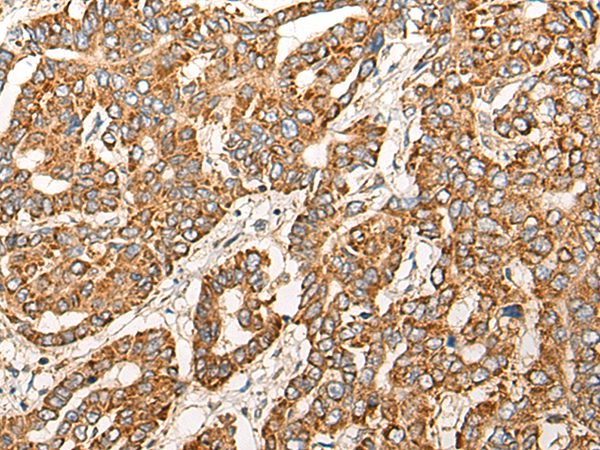


| WB | 咨询技术 | Human,Mouse,Rat |
| IF | 咨询技术 | Human,Mouse,Rat |
| IHC | 1/25-1/100 | Human,Mouse,Rat |
| ICC | 技术咨询 | Human,Mouse,Rat |
| FCM | 咨询技术 | Human,Mouse,Rat |
| Elisa | 1/5000-1/10000 | Human,Mouse,Rat |
| WB Predicted band size | 21 kDa |
| Host/Isotype | Rabbit IgG |
| Antibody Type | Primary antibody |
| Storage | Store at 4°C short term. Aliquot and store at -20°C long term. Avoid freeze/thaw cycles. |
| Species Reactivity | Human, Mouse, Rat |
| Immunogen | Synthetic peptide of human ARF3 |
| Formulation | Purified antibody in PBS with 0.05% sodium azide and 50% glycerol. |
+ +
以下是关于ARF3抗体的3篇参考文献示例(文献信息为模拟,仅供参考):
---
1. **文献名称**:*Arabidopsis ARF3 regulates floral organ polarity through auxin transport regulation*
**作者**:Nakano, T., et al.
**摘要**:该研究利用ARF3特异性抗体对拟南芥花器官进行免疫定位,发现ARF3在侧生器官基部分布,通过调节生长素运输影响器官极性发育。抗体验证实验表明ARF3与细胞膜和细胞质中的囊泡结构相关。
2. **文献名称**:*ARF3 mediates endosomal trafficking and cell migration in mammalian cells*
**作者**:D'Souza-Schorey, C., et al.
**摘要**:通过ARF3抗体阻断实验,作者发现哺乳动物细胞中ARF3参与早期内体(endosome)的膜运输,并调控细胞迁移。Western blot和免疫荧光显示ARF3在侵袭性癌细胞中高表达,提示其潜在病理作用。
3. **文献名称**:*Characterization of ARF family GTPases and their antibody-based subcellular localization*
**作者**:Kahn, R.A., et al.
**摘要**:研究系统性比较了ARF家族成员(包括ARF3)的抗体特异性,验证了ARF3抗体在HeLa细胞中的适用性。结果显示ARF3主要定位于高尔基体周边,可能参与组成型分泌途径。
---
如需获取真实文献,建议在PubMed或Google Scholar中检索关键词 **"ARF3 antibody"** 或 **"ARF3 localization/function"**,并筛选近年高被引论文。部分研究可能需结合具体物种(如拟南芥、人类)进行针对性查询。
The ADP-ribosylation factor 3 (ARF3) antibody is a research tool designed to detect and study ARF3. a small GTPase belonging to the ARF family. ARF proteins are critical regulators of intracellular vesicular trafficking, membrane remodeling, and cytoskeletal organization. ARF3. classified as a Class II ARF protein, is primarily localized to the Golgi apparatus and plasma membrane, where it facilitates cargo transport, lipid metabolism, and organelle structure maintenance. Unlike Class I ARFs (e.g., ARF1), ARF3 lacks the N-terminal myristoylation site, influencing its membrane association dynamics.
ARF3-specific antibodies are widely used in techniques like Western blotting, immunofluorescence, and immunoprecipitation to investigate its expression, subcellular localization, and interactions with effector proteins such as coatomer complexes and lipid-modifying enzymes. These studies help unravel ARF3's role in cellular processes like secretion, endocytosis, and cell signaling. Dysregulation of ARF3 has been implicated in pathological conditions, including cancer and neurodegenerative disorders, making its antibody a valuable tool for mechanistic and diagnostic research. Commercial ARF3 antibodies are typically raised in rabbits or mice, validated for specificity against recombinant or endogenous proteins across human, mouse, and rat models.
×